The X Button
Fighting for Nothing
by Todd Ciolek,

Welcome to another edition of The X Button, now featuring game-related political commentary!
I trust that Dragon Quest's status in Japan is well-known. It's practically a cultural institution, and every major game in the series creates large crowds and stifles productivity at schools and offices across the nation. That was the way of it on June 10, when fans lined up early in the morning to buy Dragon Quest IX and give some of their money to a man who thinks the Nanking Massacre never happened.
I'm talking about Koichi Sugiyama, the esteemed composer who's scored Dragon Quest games for as long as the franchise has existed. While that's earned him a favorable reputation among game geeks, Sugiyama is also one of those people who denies that Japan committed any real atrocities during World War II. In public advertisements, Sugiyama argues that the Nanking Massacre, the extensively documented slaughter of around 300,000 Chinese civlians and captured soldiers, was completely fabricated and that Korean women were never forced into prostitution by the Japanese military.
Sugiyama is hardly Japan's only World War II revisionist, and I don't doubt that there are others in the game industry (and, for that matter, the anime industry) who decry the existence of the Nanking Massacre and other Japanese war crimes. Yet Sugiyama is so prominent with his opinions that I'm surprised when Dragon Quest fans don't seem to care. You'd think they would at least consider the small percentage of their money that indirectly supports Sugiyama's loathsome politics.
I'm also surprised that Sugiyama's insanity isn't covered more in the Western gaming press. I've even seen some there shrug off his nationalism as the ravings of a harmlessly angry old man, and that sort of glib dismissal sickens me. This is not your grandfather describing his neighbors with mildly racist epithets. It's a celebrated composer ignoring all evidence and pretending that hundreds of thousands were never butchered by Japanese forces. Sugiyama and those who share his views are no better than the lunatics who think the Holocaust never happened, and they should be treated with similar contempt.
Wasn't this column supposed to be about video games? Let's discuss them.
NEWS
NAME THAT ATLUS BRAWLER
The high-school punk is often ignored in modern games, which prefer adult criminals or god-slaying Grecian thugs in their displays of violence. Perhaps that's why no one localized the first two Kenka Bancho games. However, Atlus has Kenka Bancho 3 coming to the PSP in North America, and they're asking fans to give it an English title.
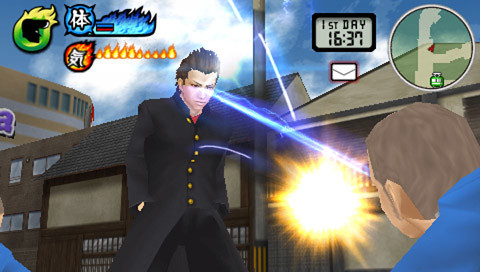
Kenka Bancho 3 may emphasize the fisticuffs common to all teenage gangs, but it's more than just another 3-D Double Dragon echo. Upon choosing a customized look for their hero, players get to roam around on a school trip, upgrading attacks, going on dates, and pounding on all sorts of rival bullies. The fighting leads to showy explosions and other overblown moves, with the best one being a laser-beam stare sure to destroy the spirit of any greasy teenage tough. These side attractions all make Kenka Bancho 3 close to the classic River City Ransom. I vote that Atlus rename it River City Rumble, even if that's not one of the titles on the survey.
NIS MIXES MUSIC AND RPGS ONCE AGAIN
 Nippon Ichi Software may be known primarily for Disgaea nowadays, but their first game to reach North America was Rhapsody: A Musical Adventure, a lightweight RPG with lots of sugary songs about feeling sad and things looking bad. That spirit now lives on in Princess Antiphona's Hymn: Angel's Score Op.A, the PSP follow-up to the Puppet Princess series that spawned Rhapsody. Antiphona shows off largely 2-D visuals, with the same cute style that marked Rhapsody and its relatives. The combat even resembles the side-view battles from the DS version of Rhapsody (and not the original's grid-driven ones). It's out in Japan this October, and I expect to see NIS America announce it by the end of the year.
Nippon Ichi Software may be known primarily for Disgaea nowadays, but their first game to reach North America was Rhapsody: A Musical Adventure, a lightweight RPG with lots of sugary songs about feeling sad and things looking bad. That spirit now lives on in Princess Antiphona's Hymn: Angel's Score Op.A, the PSP follow-up to the Puppet Princess series that spawned Rhapsody. Antiphona shows off largely 2-D visuals, with the same cute style that marked Rhapsody and its relatives. The combat even resembles the side-view battles from the DS version of Rhapsody (and not the original's grid-driven ones). It's out in Japan this October, and I expect to see NIS America announce it by the end of the year.
BATTLE FANTASIA TO ARRIVE ON PSN
Battle Fantasia was neglected last year, when its gentle medieval-fantasy style didn't really sit right with the sort of person who pays $60 for fighting games. Some were also annoyed that only the game's Xbox 360 version came out in North America. Well, the latter problem is solved, as Battle Fantasia is heading to the U.S. PlayStation Network in the fall. The game supports all of the same features as the 360 version, and Aksys is adding some extra trophies that will be named by fans.
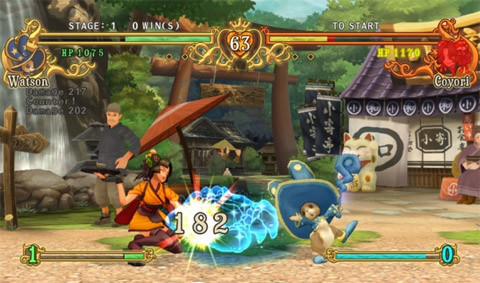
I earnestly recommend Battle Fantasia to those seeking something aesthetically different in a fighting game, especially after the flashy but distressingly familiar stylings of BlazBlue. Fantasia's soft, friendly look is novel for a genre usually fond of deadly robots and samurai and pirates. And it has a bunny magician.
HUDSON BRINGS WII HORROR GAME WEST
 Hudson's Calling may be a little behind the horror-movie curve, since at least one film already explored the idea of evil websites. Yet Calling is still new ground for video games and Wii titles, and Hudson's bringing it to North America in the spring, according to Siliconera.
Hudson's Calling may be a little behind the horror-movie curve, since at least one film already explored the idea of evil websites. Yet Calling is still new ground for video games and Wii titles, and Hudson's bringing it to North America in the spring, according to Siliconera.
Split into chapters that each center on a different lcast member, Calling strongly resembles Fatal Frame in its gloomy, ghost-stocked settings that appear to be some purgatorial cage. Players wield a flashlight with the Wii remote, which also doubles as a cell phone by playing calls and eerie effects in one's ear. That might well create a properly scary atmosphere, even if some of the screens (right) look less like a survival horror title and more like someone playing with the character models in Half-Life 2. Either way, it's another Wii game that isn't Birthday Party Bash or Alvin and the Chipmunks.
FULLMETAL ALCHEMIST HITS THE PSP IN PAIRS
Fullmetal Alchemist: Brotherhood's inevitable following of games now spreads to the PSP with Fullmetal Alchemist: Senaka wo Takuseshi Mono. A 3-D action game of sorts, it leans heavily on two-character teams from the anime series, with each combination creating new attacks. The headliners are Ed and Al and Mustang and Hawkeye, though I imagine there'll be some Homunculis and other characters tossed into the fray. Armstrong and Sig Curtis, for example.
SPECIAL FEATURE: UNDERGROUND FIGHTING
Nothing shows off Japan's underground game-development scene like its fighting games. Visual novels, shooters, and dating simulators are cranked out constantly there, yet it takes a little more effort to develop a complete fighter, with animated characters, combo systems, and enough well-planned mechanics to make it worth a second play. Dubbed “doujin fighters” by those who follow them closely, these indie specimens rarely threaten the complexity and polish of legitimately made fighters (some of the more impressive doujin fighters are built with ASCII's fighter-maker program). Yet they're also completely outside of mainstream controls, leaving their creators free to violate copyrights, stuff them with anime nonsense, and push whatever boundaries they choose. More importantly, many of them are available free online.
VANGUARD PRINCESS
There's a general lack of big-name fighters dedicated entirely to otaku-pleasing “moe” girls, with only Examu's Arcana Heart exploiting this demanding sector in full. The sub-industry of doujin fighters often picks up the slack by cranking out games stocked entirely with female combatants over which players can fawn. Vanguard Princess is the latest and the most professional in appearance.
I will admit for clarity's sake that Vanguard Princess is Not My Thing, as it's full of gossamer-haired girls of every major anime stereotype and fetish, from a superheroine in combat lingerie to an Aria-like staff-warrior to a gunslinger dressed in a loincloth and two selectively placed frills (though she's still more dignified than Noel from BlazBlue). The most troubling is one of the support fighters, who looks like a Japanese cartoon version of a little girl in maid-like bondage gear. Maybe the game's defenders should pretend that she's really a dwarf hooker like the one in Total Recall.
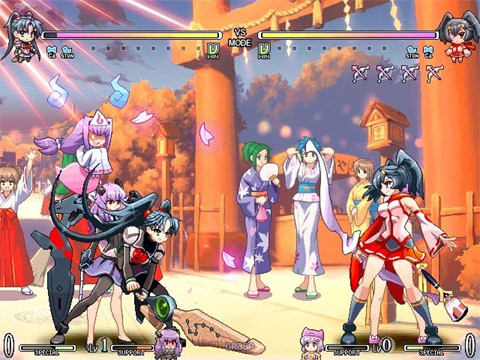
That said, Vanguard Princess looks technically amazing. The characters are crisp and shiny beyond anything one would expect from an independent fighter, and battles sparkle with all manner of effects and voice samples. The gameplay shuns a lots of modern conventions for two-character strikes; each fighter can be paired with one of four disturbingly younger-looking sidekicks, and these small strikers pace in the background until a button-press brings them out for an attack. The fighting engine isn't too hard for “serious” players to abuse, but the game's creator, former Capcom employee Tomoaki Sugeno, apparently puts out updated versions of it.
The entirety of Vanguard Princess is free to download. It takes a bit of trickery (and possibly NTLEA) to get it running, but that should prove worth the effort if its visual style strikes some unflattering fancy within you.
Of course, there are far more doujin fighters than Vanguard Princess, and many of them aren't targeted so acutely at the moe-maid-schoolgirl-underwear sort of fan. The following are some of the more approachable highlights, but they're by no means the limit of what the world of fan-made fighting games can create.
MELTY BLOOD
 I hesitate to include Melty Blood here for certain reasons. As the doujin-fighter scene's biggest success story, it began as a fan-made 2-D tribute to the Tsukihime visual novels (which are known here more through their anime and manga derivatives). Unlike just about every other underground fighting game, Melty Bloodearned some respect among those types who normally turn up their noses at fighters that aren't “competitive.” It has a fairly intricate combat system, and it draws in enough Tsukihime characters to support long-term matchups.
I hesitate to include Melty Blood here for certain reasons. As the doujin-fighter scene's biggest success story, it began as a fan-made 2-D tribute to the Tsukihime visual novels (which are known here more through their anime and manga derivatives). Unlike just about every other underground fighting game, Melty Bloodearned some respect among those types who normally turn up their noses at fighters that aren't “competitive.” It has a fairly intricate combat system, and it draws in enough Tsukihime characters to support long-term matchups.
So great was Melty Blood's fan base that it saw an arcade release followed by a PlayStation 2 port. This pretty much puts the game in the territory of a professional release, in the sense that you can't get the nicest, latest version for the trouble of a free, developer-sanctioned download. But hey, it's still one of the best anime-driven fighters around.
A TAISEN SHIYO
 An innocuous precursor to the modern moe-anime rebellion, Azumanga Daioh inspired all sorts of fan-made games. Most were simple, including a cat-dodging game for the GP32 and a version of Nintendo's old Manhole Game &Watch title. More ambitious souls created a fighting game featuring the main Azumanga Daioh cast. It's not exactly balanced, but few fans would ignore the chance to see Yukari, Sakaki, and other characters pound each other with fireballs.
An innocuous precursor to the modern moe-anime rebellion, Azumanga Daioh inspired all sorts of fan-made games. Most were simple, including a cat-dodging game for the GP32 and a version of Nintendo's old Manhole Game &Watch title. More ambitious souls created a fighting game featuring the main Azumanga Daioh cast. It's not exactly balanced, but few fans would ignore the chance to see Yukari, Sakaki, and other characters pound each other with fireballs.
Azumanga Daioh itself slid from prominence over the past few years, and A Taisen Shiyo isn't at the fore either. I'm not certain if it was ever given away for free, and all of the places that have it now are either paid-download sites or potentially unauthorized torrents. It's no real loss if you skip the game for those reasons, unless you're a raving Azumanga Daioh fan.
DESTRACTION DESIRE
BlazBlue recently won acclaim as the successor to Guilty Gear, but it wasn't the first game to imitate Arc System Works' stunningly ridiculous fighter franchise. No, the first truly blatant Guilty Gear clone was Destraction Desire, a freeware fighter that might really be called Destruction Desire, since the game is littered with possibly intentional typos.
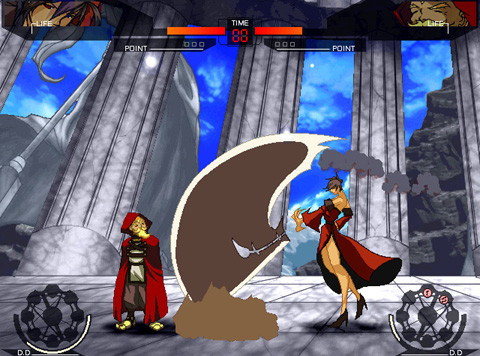
Making BlazBlue look wholly original, Destraction Desire apes Guilty Gear's visual style with the lack of shame so common to doujin fighters. The lead, Barns, is a gray-haired Sol Badguy, while his counterpart, Arenet, is a female Ky Kiske. At least the gameplay is quick and intuitive, with a power-storing gauge that actually resembles Hakumen's move stockpile from the later BlazBlue. Sadly, there are only five characters (including an apparently handless wood mage), and it leaves the game as a mere demo that the developer, Yew, never had the time or money or wherewithal to finish. Good thing it's free.
ARM JOE
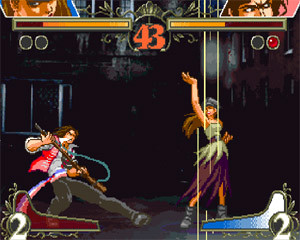 Melty Blood may be the most profitable doujin fighter, but ArmJoe is the most appealing in general geek circles. Basing a 2-D fighter on Les Miserables will get people talking, after all. While ArmJoe (a play on “Ah, Mujou,” the Japanese title for Les Miserables) could gain such notoriety for its concept alone, it's a surprisingly detailed fighter. The game engine is basic and loose, with a feature that lets players set their life meters to drain slowly in exchange for unlimited supers, and yet it's full of great little touches. Each character has a large set of varied moves, drawn mostly from the stage production (and, to a lesser extent, Victor Hugo's original novel), with results both overwrought and halfway faithful: Marius summons his fallen comrades as skeletal riflemen, Javert hurls meteors for his special attack, Cosette has Valjean fight beside her like a Stand from JoJo's Bizarre Adventure, and Enjolras pelts foes with gunned-down soldiers and an entire barricade. The developers even throw in a Ken/Ryu policeman, a comical stuffed donkey named Ponpon, a cheating brute of a final boss, and a robotic Jean Valjean. This is, of course, an inaccurate adaptation of the book, in which RoboJean was 30 stories high and destroyed half of Paris before the Count of Monte Cristo went Super Saiyan and impaled the rampaging robot on a time-warped Eiffel Tower.
Melty Blood may be the most profitable doujin fighter, but ArmJoe is the most appealing in general geek circles. Basing a 2-D fighter on Les Miserables will get people talking, after all. While ArmJoe (a play on “Ah, Mujou,” the Japanese title for Les Miserables) could gain such notoriety for its concept alone, it's a surprisingly detailed fighter. The game engine is basic and loose, with a feature that lets players set their life meters to drain slowly in exchange for unlimited supers, and yet it's full of great little touches. Each character has a large set of varied moves, drawn mostly from the stage production (and, to a lesser extent, Victor Hugo's original novel), with results both overwrought and halfway faithful: Marius summons his fallen comrades as skeletal riflemen, Javert hurls meteors for his special attack, Cosette has Valjean fight beside her like a Stand from JoJo's Bizarre Adventure, and Enjolras pelts foes with gunned-down soldiers and an entire barricade. The developers even throw in a Ken/Ryu policeman, a comical stuffed donkey named Ponpon, a cheating brute of a final boss, and a robotic Jean Valjean. This is, of course, an inaccurate adaptation of the book, in which RoboJean was 30 stories high and destroyed half of Paris before the Count of Monte Cristo went Super Saiyan and impaled the rampaging robot on a time-warped Eiffel Tower.
Most of the Internet heard about ArmJoe years back, but it still merits mention as one of the best ideas to ever emerge from the whole fan-fighter scene, and it's also free. Even if it's nowhere near the competition of a professional fighter, it's fun enough to make you wish that ArmJoe really was an official creation from SNK or Capcom, baiting copyright lawyers and driving fighter enthusiasts to debate whether or not Eponine's healing rain and ducking slide-kick make her top-tier or just a scrub character.
VALKYRIE FIGHT TAG
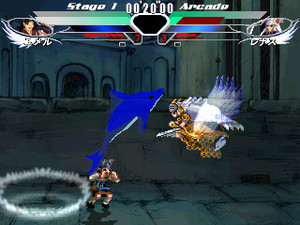 Lastly, I would be no sort of Valkyrie Profile fan if I didn't shill Valkyrie Fight Tag, a freeware game that rather brazenly uses the characters of the first Valkyrie Profile in a primitive 2-D fighter. The original game had no versus-fighting mode, but Fight Tag suggests that it should have, since the sprites and hectic battles of Valkyrie Profile ably lend themselves to a fighting game. Getting that game free is a pleasant change from Star Ocean 3, which included a versus mode that you had to unlock after hours of boring RPG playtime.
Lastly, I would be no sort of Valkyrie Profile fan if I didn't shill Valkyrie Fight Tag, a freeware game that rather brazenly uses the characters of the first Valkyrie Profile in a primitive 2-D fighter. The original game had no versus-fighting mode, but Fight Tag suggests that it should have, since the sprites and hectic battles of Valkyrie Profile ably lend themselves to a fighting game. Getting that game free is a pleasant change from Star Ocean 3, which included a versus mode that you had to unlock after hours of boring RPG playtime.
As a fan production, Valkyrie Fight Tag was programmed with broad direction and allows plenty of cheap tactics. Still, it packs in every major Valkyrie Profile character and lets players control them in teams. It's best taken as a fans-only affair, but for those who devour every Valkyrie Profile that Square Enix deigns to greenlight, Valkyrie Fight Tag must be downloaded.
RELEASES FOR THE WEEK OF 7-19
LITTLE KING'S STORY Developer: Marvelous/Cing Inc.
Developer: Marvelous/Cing Inc. Publisher: XSEED Games Platform:Wii Players: 1 MSRP: 49.99 Free Preorder Stuff: A squishy Onii stress doll Little King's Story will surely be compared to Square Enix's Final Fantasy Crystal Chronicles: My Life as a King, as both games charge players with the same task: build a barely existing kingdom into a thriving empire, expanding your borders while keeping your citizenry pleased. Little King's Story has a slightly cuter look to it and a strategy-RPG cast to its battles. It also shares a bit with the multifaceted simulation of Harvest Moon, as becoming a true king involves military struggles, careful choices, and marriage. Spurred on by a warmongering minister, the player directs an initially small droplet of subjects, encouraging them to take up various jobs in the course of building the kingdom. Once you've amassed an army, the game leads to large-scale battles where archers, cavalry, and other units help to bring down rival nations. Of course, you can make nice with some neighboring countries, but where's the ruthless conquest in that? |
EXTRA LIVES: TEKKAMAN BLADE
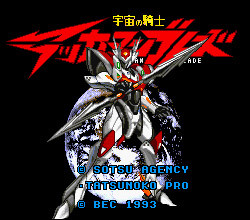 A Tekkaman Blade game never stood a good chance of coming to North America. Sure, the series was airing in the dubbed and censored form of Teknoman in the mid-1990s, but no publisher was going to bring Teknoman to the Super NES at a time when ravenous legions of petition-writing fans couldn't get any Sailor Moon games released in the West. Teknoman didn't become the Robotech of its day, and it's now remembered mostly for concocting a hilariously overdramatic introduction and making a homosexual character into a woman. The Super Famicom game is also obscure, and anyone who hunts it down, be they fans of Tekkaman Blade or Teknoman, might not like what they find.
A Tekkaman Blade game never stood a good chance of coming to North America. Sure, the series was airing in the dubbed and censored form of Teknoman in the mid-1990s, but no publisher was going to bring Teknoman to the Super NES at a time when ravenous legions of petition-writing fans couldn't get any Sailor Moon games released in the West. Teknoman didn't become the Robotech of its day, and it's now remembered mostly for concocting a hilariously overdramatic introduction and making a homosexual character into a woman. The Super Famicom game is also obscure, and anyone who hunts it down, be they fans of Tekkaman Blade or Teknoman, might not like what they find.
For one thing, they won't find much of Tekkaman Blade's plot recreated in the Super Famicom game. It offers close-ups of leading space superhero Blade and his transformation, plus a few curt pre-fight conversations with stage bosses. If you want a story about futuristic astronaut-knights slashing through each other with hypersonic javelins while suspiciously androgynous mechanics obsess over machines, there's always the actual show.
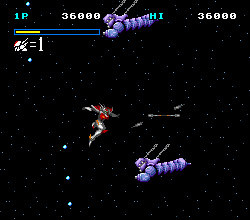 Tekkaman Blade builds up its anime tribute by mixing genres. When the first level plunges a transformed Blade into an asteroid field, it seems to be a traditional side-scrolling shooter. Poke around with the controls, though, and you'll find that Blade can't really shoot things. Instead, he can hurl his staff and slash enemies at close range. Everything else is set up much like an R-Type or Gaiares: enemy creatures and ships appear in waves, and Blade's often held up by obstacles, some of which can be destroyed. Fortunately, Blade gets a life meter instead of collapsing after one hit, as he'd likely do in a standard shooter.
Tekkaman Blade builds up its anime tribute by mixing genres. When the first level plunges a transformed Blade into an asteroid field, it seems to be a traditional side-scrolling shooter. Poke around with the controls, though, and you'll find that Blade can't really shoot things. Instead, he can hurl his staff and slash enemies at close range. Everything else is set up much like an R-Type or Gaiares: enemy creatures and ships appear in waves, and Blade's often held up by obstacles, some of which can be destroyed. Fortunately, Blade gets a life meter instead of collapsing after one hit, as he'd likely do in a standard shooter.
The end of each stage breaks into another type of game: the one-on-one fighter. Upon confronting a boss with a name like Axe or Evil or Charity Embezzlement, Blade enters a side-view duel with said foe. These battles play out like primitive fighting games, and it's easiest just to hit your opponent and ride out the timer by running away. Some curiosities emerge, though; as in the shooting stages, each of Blade's new lives revives him on the spot, so he effectively has three life meters to any boss's one. It's also possible for both Blade and the bosses to lose their weapons, which sometimes makes Blade more maneuverable than he is when armed.
Developer Interbec deserves some credit for staying faithful to the Tekkaman Blade show with a slashing faux-shooter, but it soon reveals an ugly truth: the game's less enjoyable than it would be if it were merely another generic space blast-'em-up. Throwing Blade's staff is awkward, and his close-range strikes require you to get cozy with enemies who are invariably firing bullets or crashing into you. Tekkaman Blade can be challenging throughout its seven stages, but it's rarely fun.
 The fighting-game boss battles are even less notable, as it seems like Interbec mimicked Street Fighter II without actually playing the game. The bosses behave stupidly, the animation is slow, and Blade's often hard to handle. These bouts also highlight the game's lack of visual panache, as a victorious Blade just looks out at the player instead of striking a signature Tekkaman Blade pose, whatever they might be. Tekkaman Blade looks average for a 1993 16-bit game, and it could just as easily be a TurboGrafx-16 title from 1989 (my apologizes for re-opening old TurboGrafx wounds, but you must admit its shortcomings). The soundtrack has a thumping pace right out of a Genesis shooter, even if that does little to enliven the haphazard play of the shooter levels.
The fighting-game boss battles are even less notable, as it seems like Interbec mimicked Street Fighter II without actually playing the game. The bosses behave stupidly, the animation is slow, and Blade's often hard to handle. These bouts also highlight the game's lack of visual panache, as a victorious Blade just looks out at the player instead of striking a signature Tekkaman Blade pose, whatever they might be. Tekkaman Blade looks average for a 1993 16-bit game, and it could just as easily be a TurboGrafx-16 title from 1989 (my apologizes for re-opening old TurboGrafx wounds, but you must admit its shortcomings). The soundtrack has a thumping pace right out of a Genesis shooter, even if that does little to enliven the haphazard play of the shooter levels.
For the well-connected fan of 1993, Tekkaman Blade's Super Famicom game might've impressed an anime club's worth of dingy college kids. Now, it's just a middling semi-shooter and a sixth-rate fighting game, slapped together without care or cohesion. Perhaps it'll serve some Tekkaman Blade worshipper who insists that the show can be popular again. If that's the case, don't bother actually playing it. Just stick it on your mantel and you'll have constant proof that the series was popular in the first place.
Tekkaman Blade hovers around the $20 range, which seems the going rate for forgotten Super Famicom games based on 1990s anime series. Remember that, as always, you'll need either a converter or a some minor console surgery to run Super Famicom cartridges on a Super Nintendo.
discuss this in the forum (40 posts) |
this article has been modified since it was originally posted; see change history